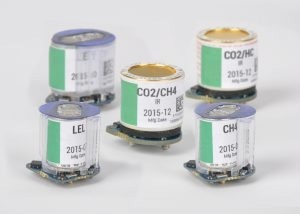Sensor poisons are chemicals which inhibit the sensors from carrying out their function properly. Even though sensors in portable gas detectors are designed to be exposed to gases, including those that are corrosive and toxic, or explosive, they are still susceptible to inhibition by sensor poisons or inhibitors. These can be in the form of ordinary lubricant or cleaning chemicals, or specialized products, depending on the type of sensor.
Among those which are affected the most is the catalytic bead LEL sensor, which is standard in gas detection for a variety of applications. This is one reason that knowing what can act as a sensor poison is so important, allowing the user to understand if the monitor is working as designed or allowing dangerous exposure to flammable gases without setting off an alarm.
A catalytic bead LEL sensor is among the most typically used sensors in this category, but its mechanism of detection determines its vulnerability to sensor poisons and inhibitors. Fundamentally, this sensor ignites the gas to which the bead is exposed, and detects the temperature change that results, to convert it into a gas level reading displayed on the screen.
The presence of inhibitors or poisons may reduce or prevent gas combustion, and thus the readout shows lower than actual values or no reading is possible. Both poisons and inhibitors act in somewhat the same manner but affect the sensor differently as well as being introduced in different ways.
How Sensor Poisoning Occurs
Sensor poisons commonly encountered include silicone-based products, lubricants, additives in various gases, sulfur, and lead compounds. The way in which these act is as follows: the catalytic bead begins to become hot once the instrument is switched on, and it heats up any poison in contact with it. The poison melts almost at once and coats the bead surface irreversibly.
This demands sensor replacement if the device is to work, since the encapsulated bead can no longer burn the flammable gas that comes into contact with its surface. Thus, it does not give a readout. The danger lies when the instrument has not been regularly calibrated or bump tested as recommended, because the lack of readout is no longer reliable.
The user can no longer tell if the detector is working properly and verifying the absence of combustible gas in the environment, or simply not functioning because the sensor has been poisoned. Thus, any suspicion of bead poisoning should lead to taking immediate action to calibrate the sensor to confirm its condition.
Provided the calibration gas is read by the sensor, which gives an appropriate readout, it can detect gas on the ground, but if no readout is provided following the application of the calibration gas, the sensor has failed the calibration test.

Some of the most common poisons are silicone-based products, lubricants, gas additives, lead, and sulfur compounds.
Action to be Taken if Sensor Poisoning is Suspected
Inhibitors may affect the sensor’s effectiveness, though less completely compared to sensor poisons. One example is the presence of both inhibitors and combustible gases in the same mixture. The catalytic bead in the sensor can now no longer detect the gas.
The effects of a sensor inhibitor are to increase the level at which detection is possible, and to reduce the working life of the sensor. However, if the sensor is calibrated and bump tested it may still work to acceptable limits. Frequently encountered inhibitors include halogenated compounds.
Following exposure to sensor inhibitors, the instrument should be calibrated at once to confirm that the sensor still works. Following the burning of the flammable gas introduced from the calibration cylinder at the surface of the catalytic bead, the inhibitor stuck to the bead is also burnt off in part. However, if the sensor is exposed to inhibitors repeatedly or in large amounts it may not be possible to salvage it, and the calibration may fail.
Sometimes it is immediately recognized that the sensor is exposed to a poison or inhibitor, but it may also be missed. For instance, several lubricating compounds or silicone-based chemicals are available in a spray form, which covers a lot of area outside the specific target zone. Thus, if a personal gas detector is placed in its proximity, it may be covered with the spray fully or partially.
Moreover, these products are often slow to dry, and they give off vapors and chemicals as they dry. Another area of concern is the manner of storage, for while a gas detector is stored with other chemicals, in a locker or tool box, for instance, it may be exposed to a poison or inhibitor, even if it is protected from such exposure during the period of active use.

If there is any thought that the LEL sensor may have been poisoned, it should be calibrated immediately to make sure it is in working order.
How to Deal with Sensor Poisoning
Since this article describes some common sources of sensor poisoning or inhibition, it may be understood that a gas detector should be calibrated, and bump tested each day, as well as repeating the calibration on any suspicion of sensor contact with such substances.
This will help you maintain the good condition of the instrument, so that it detects gas as it is meant to do. However, if calibration of an instrument whose sensor has been possibly poisoned or inhibited results in a failed result, it means the instrument should be serviced before being used for gas detection again.

This information has been sourced, reviewed and adapted from materials provided by Industrial Scientific.
For more information on this source, please visit Industrial Scientific.